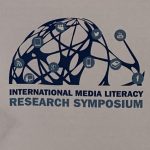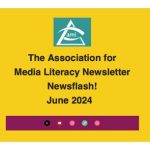Through and About
by Neil Andersen
Note: These two images, representing “about” and “through” come from the icon collection from The Noun Project. We are permitted to use these images under the Creative Commons licence, provided we give attribution to the artists.
through by Leszek Pietrzak from <a href=”https://thenounproject.com/browse/icons/term/through/” target=”_blank” title=”through Icons”>Noun Project</a>
about by feri ulan taufiq from <a href=”https://thenounproject.com/browse/icons/term/about/” target=”_blank” title=”about Icons”>Noun Project</a>
Through and about is a media literacy big idea because it derives directly from a famous Marshall McLuhan axiom: The medium is the message. This axiom means that the effects of the content of any media experience are much less important than the effects of the medium that communicates that media experience.
A way of understanding through and about is to consider content and form. The content is the meaning that we receive from the content of a message; the form is the meaning that we receive from the form the message takes. Imagine someone whispering, then shouting the same word, e.g., “hello,” then “HELLO!!” and you will be activating form and content.
We might receive a news report—the content—in multiple ways. An online news service—e.g., CBC—might present words on a screen; a radio might present spoken words and sounds; a video report might present a combination of spoken words, sounds, moving images and printed words; a tweet, which is often mostly words, might include a video or graphic. Each of the different forms will impact how audiences understand and respond to the news report.
Learning through a medium means that the learning is focusing on the content of the message. Learning about a medium means that the learning is focusing on the form and the resulting effects of the media experience itself.
These ideas are important both when we consume and create media experiences. We need to be mindful about the qualities of a medium when we consume so that we can best understand and appreciate why we respond the ways that we do. We need to consider our choices of media when we create messages too: what effects do we want our message to have on our target audience? Which media and their codes and conventions might achieve those effects?
For example, we might receive a request to support a charity that is addressing climate change. Is the request in words, images, sounds or a combination of these? Which media elements—words, images and sounds—might be most effective in motivating us to support the charity? E.g., might we be more likely to act if the request includes the sounds of forest fires, storms or crying animals? Why?
Understanding about is also important when we create messages. If we are creating a party invitation, we might choose our medium and its forms. Do we want the form to be colourful or black and white? Do we want to include a music sample or a photo? Do we print the invitation onto paper and hand-deliver it, or do we email a video link? If The medium is the message, then the decisions we make about the medium and its codes and conventions (about) will be more important than the details (content).
Learning through and about media is a way of activating, understanding and appreciating The medium is the message. It means that we are exploring the form and content. Understanding and appreciating media forms is a crucial part of media literacy because the forms produce at least half of the experience. If educators are not teaching about the media they employ, they are not teaching media at all.




